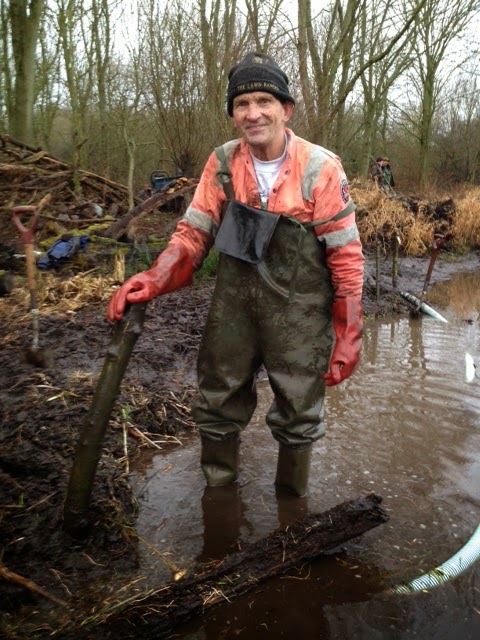Like the snow goose its provenance was limited - Frank Bell:
The northerly winds delivered upon them a respectable two Iceland gulls - separate birds on consecutive nights of the 30th and 31st found by Martin as per usual. A med gull, yellow legged gull and lesser black backed gull have perhaps been more telling of this winter all present on the 25th. North Marsh was inviting enough for this stoat snapped by Darren Smith galloping on the ice:
As the weather last week was so clement it seemed perfect for a dip; Mike gets stuck in below - only an inch of ice to get through to the warm mud beneath:
Many of you will have followed our otter holt build last year and to be fair we are still awaiting a first resident. That said it is suspected mink had moved in whilst the camera was down in recent months - and we are at last seemingly on top of our mink infestation with credit to Chris who was ensuring the traps ran 7 days a week. Hull University student Stefan Rooke's study with trail cameras appears to show no further activity after the 7th mink of autumn / winter and 8th in the last twelve months was caught two weeks ago - the worst run since Peter Izzard started trapping over 10 years ago. Many have asked if the water vole population will have survived - and it certainly will have. If they coped with mink running freely for many years they'll cope with a few individuals for a few weeks and are one of those species designed to explode again in numbers within a couple of generations.
Part of the issue with attracting otters has been that the access dyke dug at great effort by the team last year had silted back up again meaning any investigative otter would have to wade through two foot of silt. To rectify this we have dammed one end of the dyke and then pumped out all the sludge. We've then used sycamore withies to create bank protection and stop the mud slumping again - Rob and Harry weaving:
Hopefully otters like this one snapped by Steve Brimble the other day are not far off:
To undertake this we needed to lower North Marsh which coincided nicely with the need to flood Hempholme Meadow as part of its annual management to kill off dry land loving weeds. This also forces many invertebrates to the soil surface which makes good feeding for wetland birds. Untold numbers of snipe are in the meadow with the barn owl flushing multiples as it flew above the rushes looking for displaced field voles. But perhaps the star bird here has been the water rail with five present today and yielding some good photo ops (on the facebook page). We've elevated the level again today so expect more rail activity over the weekend. Little egret passes overhead by Roy Lyon:
Elsewhere the usual candidates are still about - drake scaup and red crested pochard on D reservoir - Brian Colley:
A nice drake pintail has been around on site and small numbers of curlew and redshank present on Watton. But really its spring in the air with woodpeckers creating a cacophony around the car park at the moment. For us its a race against time now trying to finish all the tree work before bird breeding season - generally reckoned to be circa March 15th when the first dunnock nests start appearing. Here managing dyke-side willow pollards with the team last weekend:
So regardless of what the tail end of winters throws up - spring's well and truly here as far as we can see with both goldeneye and the red arrows in display - Brian Colley:















